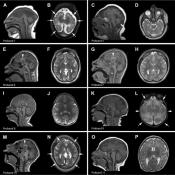Research Breakthroughs
Texas Children’s and Baylor College researchers use innovative dual-target deep brain stimulation approach to treat patients with obsessive-compulsive disorder and Tourette Syndrome
4/5/23Up to two-thirds of patients with Tourette syndrome (TS), a tic disorder characterized by sudden uncontrollable physical movements, also suffer from obsessive-compulsive disorder (OCD), a psychiatric condition characterized by intrusive thoughts and repetitive behaviors.
Imaging brain connections can predict improvements in obsessive-compulsive disorder patients after deep brain stimulation
3/27/23Deep brain stimulation (DBS) is a promising therapy for treatment-resistant obsessive-compulsive disorder (OCD). A first-of-its-kind collaborative study led by researchers at Texas Children’s Hospital, Baylor College of Medicine, and Brigham & Women’s Hospital has found that mapping neural connections in the brains of OCD patients offers key insights that explain the observed improvements in their clinical outcomes after DBS.
The clinical presentation of IDDMSSD syndrome is likely associated with the molecular location of the mutation in the PAK1 gene
3/16/23A recent study from Texas Children’s Hospital and Baylor College of Medicine has expanded the clinical spectrum of a new epileptic disorder called Intellectual Developmental Disorder with Macrocephaly, Seizures, and Speech Delay (IDDMSSD) with the identification of the first recurrently affected re
Progress in unlocking the brain's "code" for depression
3/16/23A new study in the journal Biological Psychiatry published by Elsevier advances our understanding of the basic neural circuitry of depression in the human brain. The study was led by the Cain Labs director who is also a professor at Baylor College of Medicine and Duncan NRI investigator, Dr. Sameer Sheth, Dr. Wayne Goodman at Baylor College, and Dr. Nader Pouratian at UT Southwestern Medical Center.
A comprehensive circuit mapping study reveals many unexpected facts about the norepinephrine neurons in the brainstem
3/13/23Norepinephrine-producing neurons in the locus coeruleus, a small nucleus in the brainstem, have been discovered to have two distinct types of cells that connect linearly via gap junctions - novel findings that have far-reaching implications for neuropsychiatric and neurodegenerative disorders
A study refines a molecular marker that accurately predicts the recurrence of aggressive meningiomas
2/16/23Drs. Akash Patel and Tiemo Klisch, investigators at the Jan and Dan Duncan Neurological Research Institute (Duncan NRI) at Texas Children’s Hospital and faculty at Baylor College of Medicine, have found that the loss of a single copy of CDKNA/B genes can greatly accelerate the recurrence of aggressive meningiomas, portending a poor prognosis for this subset of patients.
The therapeutic window for Angelman syndrome patients may be broader than previously reported
2/10/23Angelman syndrome is a rare neurodevelopmental disorder characterized by changes in brain structure, severe intellectual disability, impairments in speech, motor function, epilepsy, sleep, and unique behaviors that affects 1 in 10,000 to 24,000 people and for which no cure or treatment is currently available.
Texas Children’s and Baylor College scientists discover biomarkers and therapies for a group of fatal pediatric neurodegenerative disorders
2/7/23An exciting study from Texas Children’s Hospital and Baylor College of Medicine has identified molecular biomarkers and two effective approaches to treat Infantile Neuroaxonal Dystrophy (INAD), a devastating and fatal pediatric neurodegenerative disorder.
New proteins involved in Spinocerebellar Ataxia provide insight into selective neuronal vulnerability
1/10/23Neurodegenerative disorders like Alzheimer’s and Parkinson’s disease result from the loss of specific types of neurons due to abnormal accumulation of mutant proteins. Although specific brain regions have been found to be particularly vulnerable in each of these disorders, intriguingly, the disease-driving genes and the proteins they encode are usually broadly expressed and are known to function throughout the brain.
New tau regulators and therapeutic targets for neurodegenerative disorders discovered
1/10/23Neurodegenerative diseases affect millions of people worldwide and as our life expectancy increases, more individuals are expected to be affected in the coming decades. Tauopathies such as Alzheimer’s disease are a class of neurodegenerative disorders involving a pathological accumulation of tau proteins which eventually results in massive loss of brain cells.
A new neurodevelopmental epilepsy disorder and its genetic cause discovered
12/16/22Neurodevelopmental disorders (NDD) encompass highly prevalent conditions such as autism and epilepsy, with cognitive disabilities alone affecting 1-3% of the global population. Developmental epileptic encephalopathies (DEE) are NDD characterized by epilepsy and delayed development or loss of developmental skills. Although the prevalence of DEEs remains to be determined, studies estimate that single-gene epilepsies occur in around 1 in 2100 births annually.
Oxytocin drives development of neural connections in adult-born neurons
12/13/22Learning a new task, mastering a musical instrument or being able to adapt to the constantly changing environment are all possible thanks to the brain’s plasticity, or its ability to modify itself by rearranging existing neural networks and forming new ones to acquire new functional properties. This also helps neural circuits to remain healthy, robust and stable.
A novel instructive role for the entorhinal cortex discovered
11/2/22The study reveals an extraordinary and an unprecedented mechanism for synaptic plasticity.
An animal model of West syndrome exhibits a progressive increase in epileptic spasms and learning and memory deficits
11/2/22The Swann lab provides the first demonstration of a progressive increase in seizure duration along with a decline in learning and memory in the tetrodotoxin-induced model of infantile spasm.
Spontaneously arising variants in FRMD5 gene are associated with a novel neurological disease
10/7/22Researchers in the Bellen lab discover a new neurological disorder.
Researchers discover 50 novel Parkinson's disease candidate genes using an innovative multilayered approach
10/3/22Jianyang Li and others in the Botas lab use an integrated functional genomics approach to find 50 new genes involved in Parkinson's disease.
Disruption of MTSS2 function causes a new syndromic intellectual disability
9/27/22The Bellen lab discovers that a spontaneous mutation in MTSS2 gene is the underlying cause of a new syndromic intellectual disability.
A comprehensive clinical study confirms the molecular link between microcephaly caused by Zika and ANKLE2 variants
9/13/22In a first-of-its-kind study, an international team of researchers report a comprehensive phenotypic and genotypic analysis of the largest cohort to date of patients with ANKLE2 gene variants, which were identified a few years ago as the cause of microcephaly (‘abnormally small head’) in infants.
Duncan NRI team develops an award-winning new computational tool to study movement disorders
9/8/22The Duncan NRI team plan to use the Poly(A)Miner-Bulk tool to create a signature APA pattern for XDP, which can then be used to develop specific and effective diagnostic and treatment options for XDP patients. They are hopeful that if successful, this strategy can then be replicated for those with Parkinson’s disease and different forms of dystonia.
Researchers discover novel light-gated potassium channel
7/20/22The Xue lab and collaborators find a new class of light-gated channels that promise to pave the way for rapid and efficient optical neuronal silencing.



















